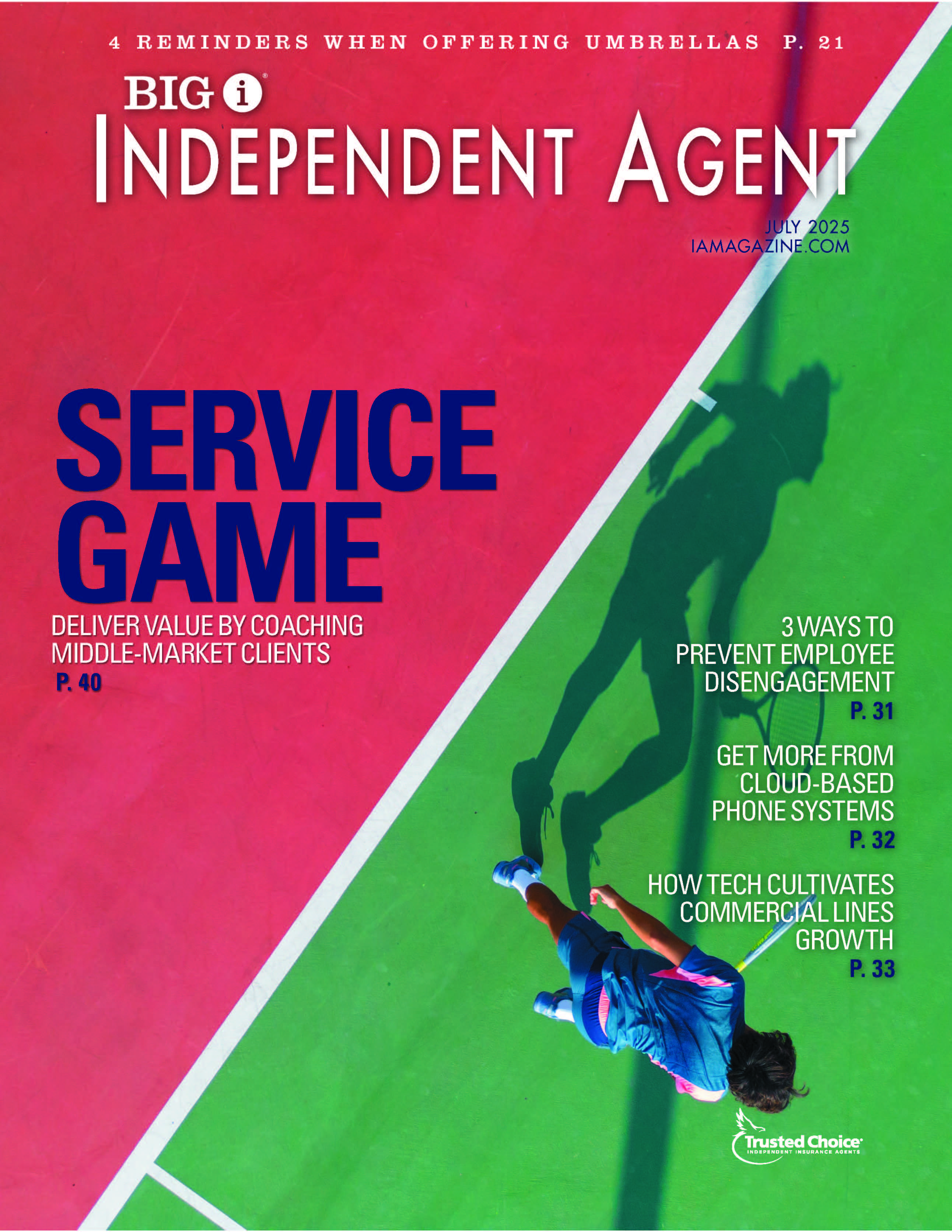Operation Organic
By: Susan Hodges
| Wellington Associates experienced its best year on record during each of the last three years. And the 13-producer agency in Flowood, Miss. is set to do it again in 2013.
Agency owner Buster Wellington attributes it all to organic growth. “It started seven or eight years ago when we began concentrating on specialty program business,” he says. “We began developing special programs our agents could sell. And we worked with carriers to get exclusive deals.”
Those special program ideas sprang from agent interests, which ranged from tow trucks to churches. Over time, the agency created additional programs in non-emergency senior transportation and public schools. “We’d see a need and we already had the expertise, so we went after the business,” says Rae Renfrow, office coordinator. “And since these programs are specialized, your standard markets won’t jump in.”
Today Wellington Associates is a Big “I” Best Practices Agency operating four separate program departments, each with two or more producers and one or more CSRs. The agency also writes personal lines, individual health and employee benefits.
Wellington is part of a trend that saw mid-size and large independent agencies and brokerages achieve record organic growth in the second quarter of 2013. According to a survey of 125 firms conducted by Reagan Consulting, median organic revenue growth for these agencies reached 6.9% for the period, compared to 5.5% for the same period in 2012. The 2013 rate is the highest reported since the survey began in 2008.
Also notable, this year’s 24% agent-broker profitability margin was the highest recorded by the survey since 2008—and is nearly 2% higher than for the same period in 2012. The survey reported that commercial lines business grew at an 8.2% median rate through the first half of 2013, while employee benefits grew at 5.5% and personal lines grew at 3.5%.
Kevin Stipe, president of Reagan Consulting, attributes the increases to a rare combination of hard property-casualty market conditions and a recovering national economy. And agency size had little or no impact on growth.
“Any time we’ve ever reviewed size as it correlates to organic growth, we found it fails to do so,” Stipe says. “Some larger agencies worry it’s harder to grow once you get to a certain size, and some smaller agencies worry they don’t have enough people or resources to grow. But the reality is, growth is unique for every agency—and many agents figure out what they need to do to make it happen.”
Double Focus At Assurance Agency, a 70-producer commercial-lines brokerage with offices in Schaumburg, Ill. and Chesterton, Mo., agents make it happen one person at a time. “We have a relentless focus on growth by winning one client at a time,” says Jackie Gould, COO. “But high retention is also key, so that as we focus on adding new clients, we’re not leaking clients out the back end.”
It works: Assurance has experienced double-digit organic growth in each of the last 10 years except 2009 (the agency grew that year too, but less than 10%). Gould explains that retention stays high in part because producers strive to serve clients in multiple disciplines. “The work we can do in employee benefits, surety bonds and 401(k) plans is as great as what we can do in p-c,” she says.
And because the brokerage’s service platform is built on creating measurable value for clients, Assurance is “not just a quoting machine,” Gould says. “We’re very focused on reducing drivers of our clients’ costs.”
Construction firms, assisted-living facilities and manufacturers are among Assurance clients with large workers-compensation exposures. In response, Gould says, the brokerage developed a strategy called Safety 360, which agents use to dive deep into client risk and analyze it from multiple perspectives before creating an insurance solution.
Safety 360 is also part of the “Selling Assurance Method,” which teaches new producers how to consult with clients. “Our organic growth engine creates opportunity for our brokers to grow their books of business and opportunities for our managers and staff,” Gould says. “When we’re out there adding new clients, we’re keeping our skills sharp and our service platform on the leading edge. We want to control our growth and direction, and the best way to do that is to stay on course with our strategy.”
Insure-Rite, a third-generation, family-owned agency in Evergreen Park, Ill., also employs a dual growth strategy. “If you’re focusing only on new business, you’re slowing yourself down,” says agency principal Pete Olson. “You’ve got to have both new business and retention to maximize opportunity.”
Olson also believes the two efforts go hand in hand because the larger an agency becomes, the easier it is for someone to get lost in the shuffle. “Maybe one of your most important customers gets hung up in the phone system—things like that happen to all of us,” he says. “So you keep building every day, because if you don’t, someone else will, and they’ll take over.”
Empowering Producers Part of Olson’s building program—which he says has contributed to organic growth of at least 30–40% per year—involves mentoring new producers. “We have over 50 producers now and when we bring one on, we want to make sure they succeed,” he says.
To make that happen, the agency pairs new producers who know little about insurance with older agents who have decades of experience. “It gives the younger producer confidence, and it takes their performance to a whole new level,” Olson says.
Olson also teams producers to pursue specific business. “We may have a producer geared toward personal lines who has an opportunity with a large auto dealer,” he explains. “We’ll team that person with a seasoned commercial-lines producer so they can go out and get the business together. We’re trying to do more of this kind of sharing, because it works really well.”
M.F. Block, a rural nine-producer agency in Paragould, Ark., engages in a different kind of sharing—that between principals and a few carefully chosen producers. “Our approach used to be, ‘Oh, this guy wants to sell for us? Come on!’” says agency partner Phillip Greer. “But we’ve come to realize that producers represent a huge cost in time and other resources, so we’ve stepped back over the last year and re-evaluated.”
“Doing it the other way, we had more turnover—and turnover costs money,” says agency partner Kirk Cupp, who says producers left because neither he nor Greer had enough time to work with them. “Time is our biggest resource, and we realize that now. We’d much rather invest in fewer producers and be able to empower them to achieve their goals and our goals.”
But with empowerment comes accountability. “Producers who work here know they have numbers to make every month,” Greer says. “We hold them accountable to the point where if they don’t make their numbers, they can lose their job.”
The other end of accountability lies with agency principals. “It’s our job to provide our producers with resources and training, and that’s something we constantly deal with,” Cupp says. “You can’t outrun your resources.”
Markets First At Pierson & Fendley Insurance, LLC, in Paris, Texas, partner Matt Frierson wanted to add resources in the form of more producers. “But there’s only so much market share you can occupy in a rural community,” he says. “We knew we’d have to pursue acquisitions first to broaden our net.”
Pierson & Fendley purchased two agencies in 2011–2012 and also set up a satellite office. “We expanded our geographic range by 100 miles,” Frierson says. “Then we added four producers, doubling our sales force.”
The new producers didn’t come all at once, however. Finding and hiring the agency’s newest salesperson, a former landscaping contractor, took more than a year. “We have some carriers that don’t have run-of-the-mill business, and we want to capitalize on that,” Frierson says. “Our new producer can go to his former competitors, talk about some of the struggles they’re going through and try to bring a solution.”
Frierson says the agency’s organic growth has evolved from a simply reporting at month’s end to targeting business and bringing it in. “Instead of getting to the end of the month and knowing we’d better put something on the books, we’re looking at the types of business we’re going after, the brand we’re building, and whether we’re representing ourselves and our carriers in the best way to achieve the best results,” he says.
Susan Hodges is an IA senior contributing writer. | The Capacity Conundrum Creating capacity for growth is often a challenge for smaller agencies. “Many times when we talk with a small agency, we find the account managers are handling everything from soup to nuts,” says Nick Kormis, senior sales manager and consultant for MarshBerry, a Willoughby, Ohio-based consultancy. “To create room for growth, an agency operating this way needs to change its service model.” Jim Wochele, a sales management consultant at MarshBerry, says small agencies might need to change the sales model as well. “Do your producers have capacity for new business, or are they spending too much time on renewals?” he asks. “Have they been trained to differentiate themselves in marketplace?” To grow, Wochele says an agency must write close to 15% in new commission each year, with 10% required just to make up for normal account losses resulting from death, business closures and relocations. In Wochele’s opinion, a sustainable business model focuses not only on filling the sales pipeline, but also targeting risks the agency wants to pursue and establishing rules for going after an account. “To succeed in long-term organic growth, you need producers that are driven, competent, successful, and working on a compensation platform that allows them to prove themselves, based on activity,” Wochele says. “You also need a sound sales model that helps you continually create capacity so your producers can earn more and grow.” Phillip Greer and Kirk Cupp, principals of M.F. Block in Paragould, Ark., are working to create capacity by partnering with carriers whose growth strategy is similar to their own. “We write a lot of farm insurance, and it’s been our biggest area of organic growth in the last couple years,” Greer says. “So we work with companies that have a real work ethic to grow their business in this area.” Greer and Cupp also see rising demand in personal auto and homeowners insurance. “But weather patterns have shifted, and we’re getting a lot more wind and hail in our area,” Greer says. “So a number of carriers don’t have an appetite to grow in homeowners.” M.F. Block producers quote the entire personal-lines package and “do really well in auto,” Greer says. And while producers nurture and grow the auto business, Greer and Cupp keep their eyes peeled for carriers that want to write homeowners. “A lot of times the first year, you don’t make money on new business,” Cupp explains. “It may take two or three years to profit from an account, so we want that retention and work hard to get it.” —S.H. |









